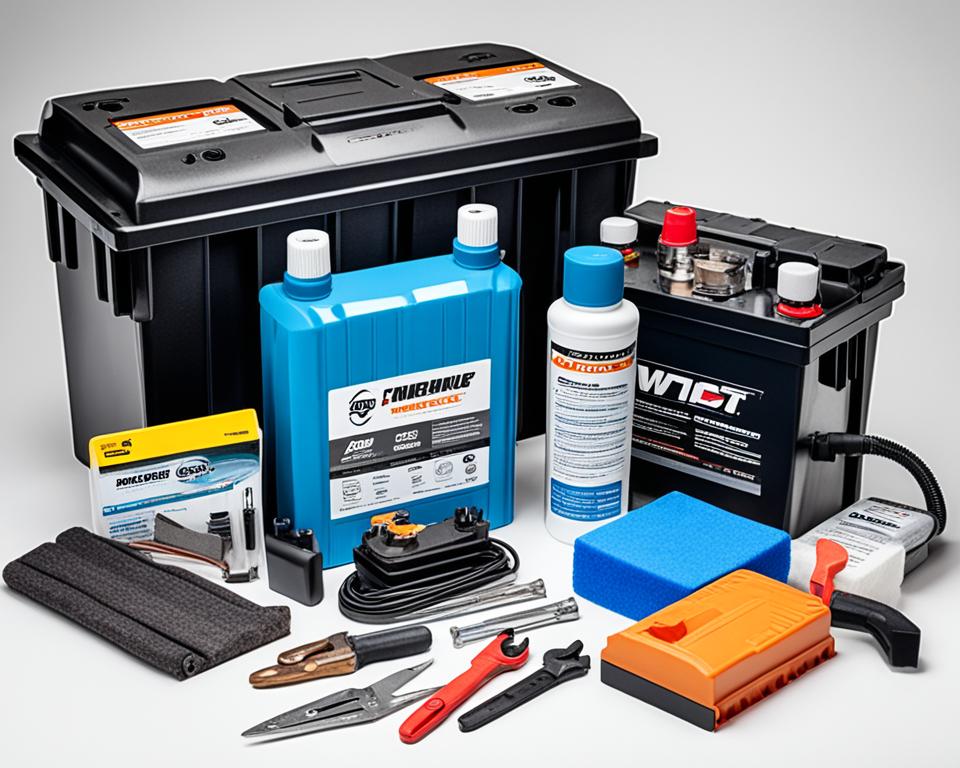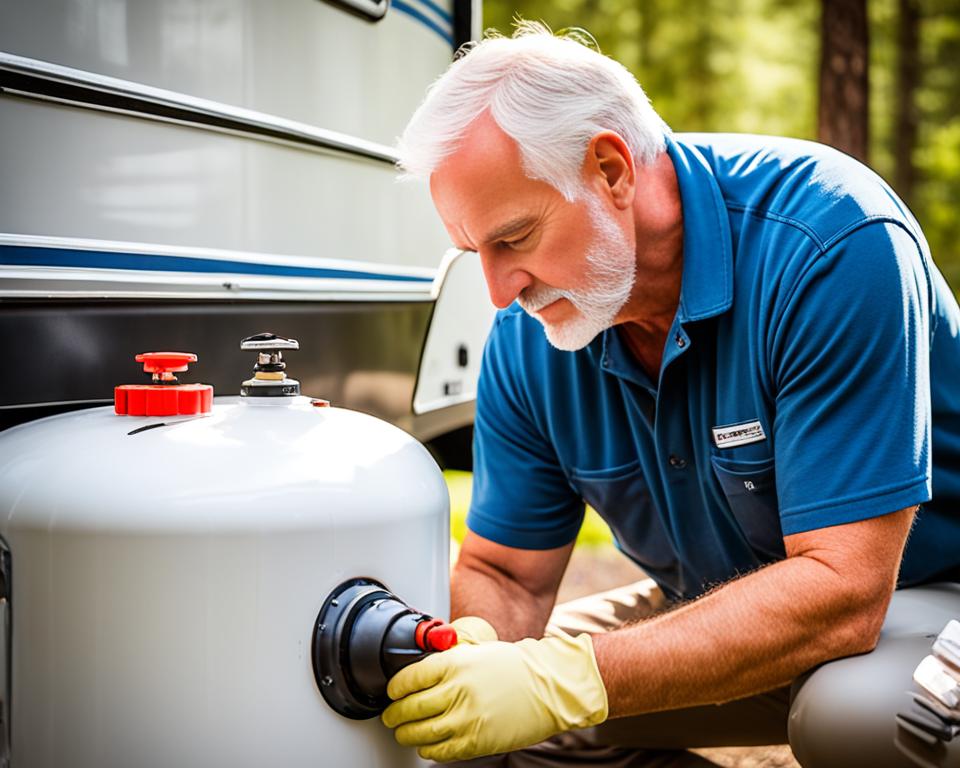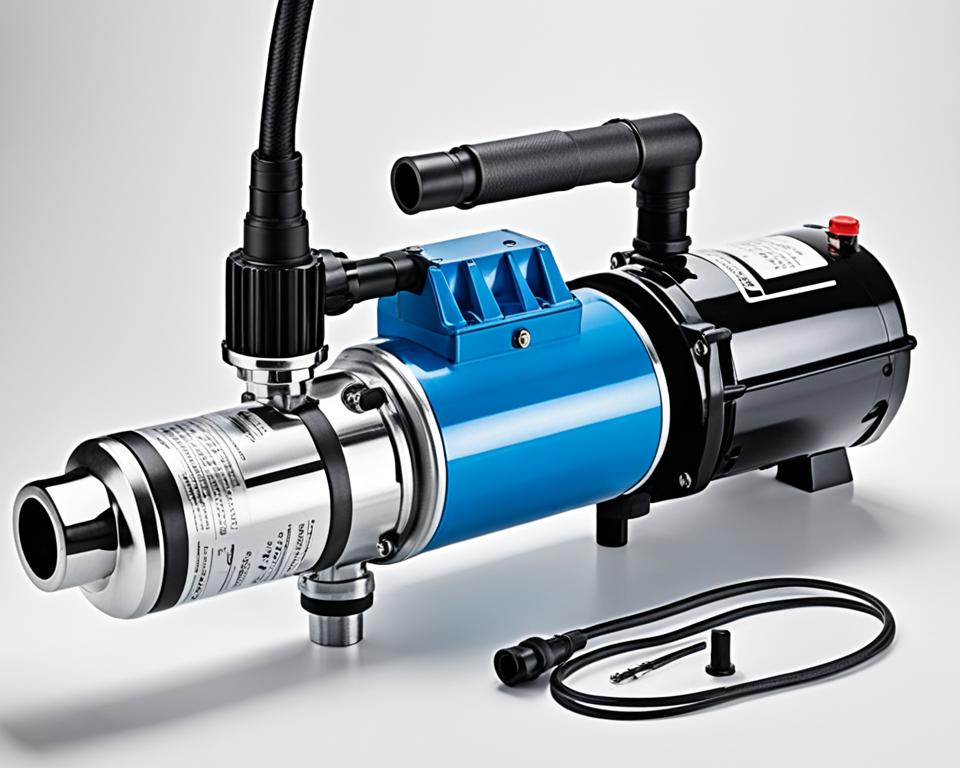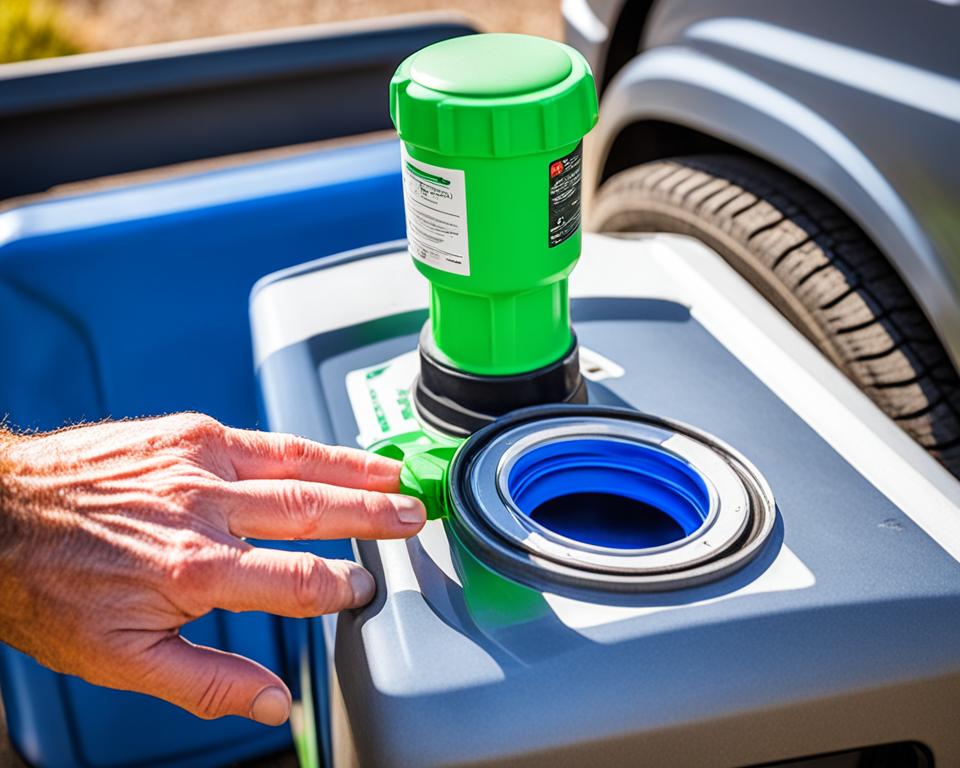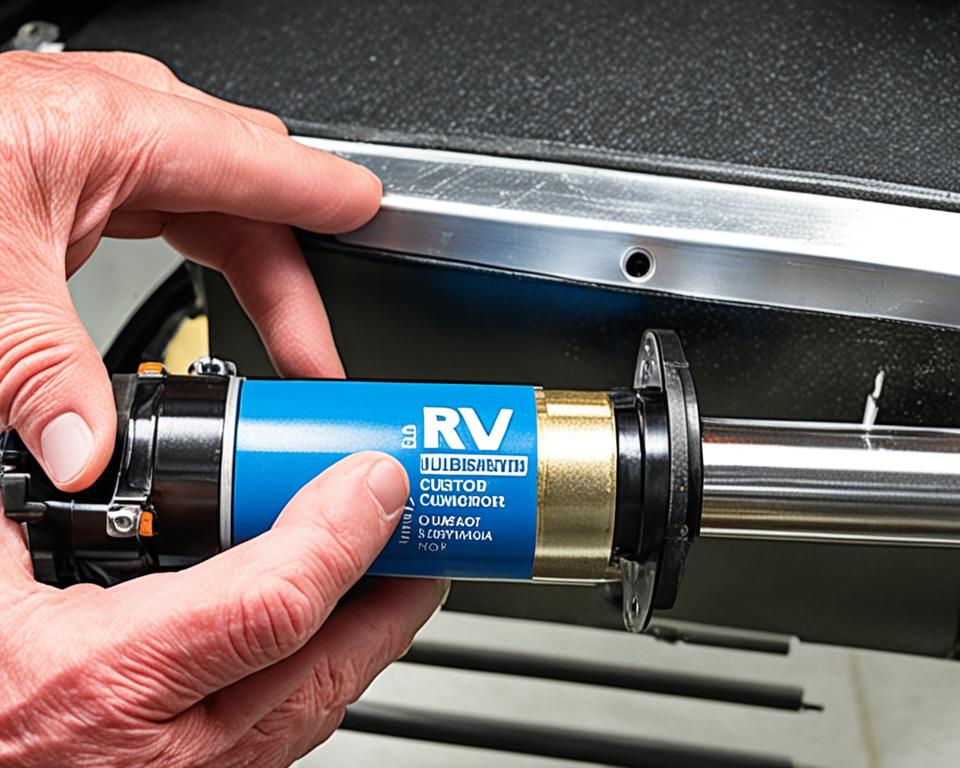Properly maintaining your RV battery is crucial for its longevity and performance. Without proper care, batteries can develop corrosion, reducing their efficiency and lifespan. To prevent this, we have compiled a list of top tips and tricks to help you keep your RV batteries in optimal condition.
Key Takeaways:
- Regularly inspect your RV batteries for signs of corrosion.
- Use water miser battery caps to minimize acid vapor escape.
- Apply a battery terminal protectant or dielectric grease to prevent corrosion.
- Consider using Thermoil liquid to create a barrier against acid vapor.
- Check and replace faulty chargers or converter/chargers.
What Is RV Battery Corrosion?
RV battery corrosion refers to the accumulation of corrosion on the battery terminals and in the battery compartment. It is a common issue that affects RV batteries and can significantly impact their performance and lifespan. The primary cause of RV battery corrosion is the reaction between gases leaking from a flooded lead-acid battery and the electrical current flowing through the copper clamps connecting the battery terminals.
This chemical reaction results in the formation of copper sulfate, a pale green-colored compound that is visible as corrosion on the battery terminals. Over time, if left untreated, this corrosion can hinder the conductivity of the battery terminals and compromise the battery’s efficiency.
“RV battery corrosion is a serious problem that can lead to poor battery performance and premature failure. It’s essential to understand its causes and take proactive measures to prevent it.”
To provide a visual understanding of how RV battery corrosion occurs, here is a simplified representation:
As shown in the diagram above, gases leaking from the flooded lead-acid battery react with the copper clamps, resulting in the formation of copper sulfate, which appears as corrosion on the battery terminals.
What Causes RV Battery Corrosion?
RV battery corrosion can occur due to several factors that contribute to the damage and degradation of the battery. Understanding these causes is essential for preventing and addressing corrosion issues effectively.
One of the main causes of RV battery corrosion is battery sulfation. This phenomenon happens when the lead sulfate on the battery plates gradually builds up over time. Sulfation can reduce the battery’s capacity, impede its performance, and increase the risk of corrosion on the terminals.
Furthermore, overfilled batteries can also contribute to corrosion. Excessive water or electrolyte levels in the battery can lead to more acid vapor escaping during the charging process. This increased vapor release can cause the buildup of corrosive substances on the terminals.
Leaking vent caps or damaged battery casing can also play a role in RV battery corrosion. If the vent caps are not intact or the battery casing has cracks, it can allow acid vapor to escape. This escaping vapor can react with the surrounding components, leading to corrosion and damage.
Finally, a faulty or misconfigured charger or converter/charger can supply the wrong voltage or current during the charging process. When the battery receives incorrect charging levels, it can result in overcharging, overvoltage, or other electrical issues. These irregularities can cause corrosion on the battery terminals and affect the overall battery performance.
In order to prevent RV battery corrosion, it is crucial to address these underlying causes and take appropriate preventive measures. Regular inspections and maintenance, proper charging techniques, and ensuring the battery environment remains clean and dry are essential steps to safeguarding your RV batteries from corrosion.
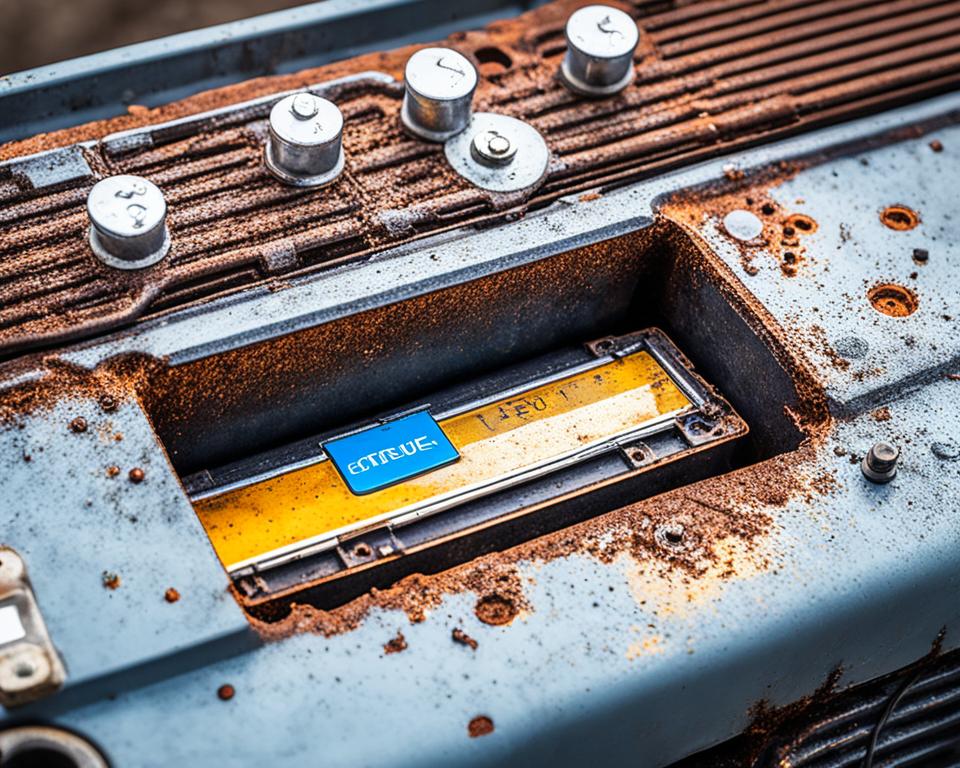
List of Causes of RV Battery Corrosion:
| Cause | Description |
|---|---|
| Battery Sulfation | When lead sulfate buildup occurs on the battery plates. |
| Overfilled Batteries | Excessive water or electrolyte levels leading to increased acid vapor escape. |
| Leaking Vent Caps | Damage to vent caps allows acid vapor to escape. |
| Faulty Charger or Converter/Charger | Supplying incorrect voltage or current during charging. |
How to Prevent or Reduce RV Battery Corrosion
Preventing and reducing RV battery corrosion is crucial for maintaining the performance and lifespan of your batteries. By taking proactive measures and implementing the right strategies, you can minimize the risk of corrosion and ensure optimal battery function. Here are some effective ways to prevent or reduce RV battery corrosion:
1. Regular Inspection
Performing regular inspections of your RV battery is essential for catching any signs of corrosion early on. Check the battery terminals, cables, and compartment for any visible signs of corrosion, such as rust or greenish deposits. If corrosion is present, take appropriate measures to clean and protect the battery.
2. Water Miser Battery Caps
Using water miser battery caps can help reduce the escape of battery acid droplets and vapor. These caps are designed to minimize the evaporation of water from the battery, reducing the risk of acid leakage and corrosion.
3. Battery Terminal Protectant
Apply a battery terminal protectant or dielectric grease to the battery terminals. This protective coating helps prevent corrosion by creating a barrier between the terminals and the corrosive elements. It also helps to maintain good conductivity and extend battery life.
4. Thermoil Liquid
Consider using Thermoil liquid, which forms a barrier on the battery cell’s electrolyte. This barrier helps prevent acid vapor from escaping and causing corrosion. Thermoil liquid is easy to apply and provides long-lasting protection for your RV battery.
5. Check/Replace Charger or Converter/Charger
Regularly check and test your RV’s charger or converter/charger to ensure it is functioning properly. Faulty or misconfigured chargers can supply the wrong voltage during charging, leading to overcharging and increased risk of corrosion. If necessary, replace the charger or converter/charger to prevent battery damage.
6. Anti-Corrosion Felt Washers
Installing anti-corrosion felt washers on the battery terminals can provide an additional layer of protection against corrosion. These washers create a barrier between the terminals and surrounding air, reducing the risk of acid vapor contact and corrosion.
By following these preventive measures and implementing the appropriate strategies, you can effectively prevent or reduce RV battery corrosion. Regular inspections, using water miser battery caps, applying terminal protectant or dielectric grease, using Thermoil liquid, checking and replacing faulty chargers, and installing anti-corrosion felt washers can help extend the lifespan of your RV batteries and ensure optimal performance.
RV Battery Maintenance 101: Preventing Corrosion and Damage
Proper RV battery maintenance is crucial for preventing corrosion and damage. By taking simple steps to care for your RV battery, you can ensure its longevity and optimal performance. Here are some essential maintenance tips to keep in mind:
Regularly Clean Battery Terminals
Corrosion on battery terminals can hinder the battery’s ability to function properly. To prevent corrosion buildup, regularly clean the battery terminals. Start by disconnecting the battery cables and then mix a solution of baking soda and water. Gently apply the solution to the battery terminals using a brush or cloth, scrubbing away any corrosion. Rinse with water and dry the terminals thoroughly before reconnecting the cables.
Apply Grease to Prevent Corrosion
After cleaning the battery terminals, applying a thin layer of grease can provide a protective barrier against future corrosion. The grease helps to keep out moisture and contaminants that can lead to terminal corrosion. Use a suitable battery terminal protectant or dielectric grease for this purpose.
Follow Manufacturer’s Charging Guidelines
Proper charging and discharging of your RV battery is essential for its overall health. Always follow the manufacturer’s guidelines for charging and discharging procedures. Overcharging or undercharging the battery can lead to irreversible damage and shorten its lifespan. It’s important to invest in a quality battery charger and monitor the charging process closely.
Perform Regular RV Maintenance
Aside from specific battery maintenance, staying on top of general RV maintenance is crucial for the overall health of your battery. Regularly inspect your RV for any signs of damage, leaks, or environmental factors that could impact the battery’s performance. Additionally, ensure that your RV’s electrical system is functioning properly, as faulty components can contribute to battery damage over time.
| RV Battery Maintenance Tips: |
|---|
| Regularly clean battery terminals to prevent corrosion buildup. |
| Apply grease or a battery terminal protectant to create a protective barrier. |
| Follow manufacturer’s charging guidelines for proper battery maintenance. |
| Perform regular RV maintenance to ensure the overall health of your battery. |

How To Clean And Protect Your Battery Terminals
To keep your battery terminals in top shape and ensure optimal battery performance, it’s essential to clean and protect them regularly. Follow these simple steps:
- Disconnect the battery cables: Begin by disconnecting the battery cables from the terminals. This ensures there’s no electrical current passing through the cables during the cleaning process.
- Mix a cleaning solution: Create a cleaning solution by mixing baking soda and water. Make a paste-like consistency that can be easily applied to the battery terminals.
- Apply the cleaning solution: Using a spray bottle, apply the cleaning solution onto the battery terminals. Ensure the terminals are well-coated with the solution.
- Allow it to sit: Let the cleaning solution sit on the terminals for a few minutes. This gives it time to break down and loosen any corrosion or buildup.
- Scrub away corrosion: Use a wire brush or toothbrush to scrub away the corrosion from the battery terminals. Gently scrub in circular motions to remove any stubborn residue.
- Rinse off the solution: Once the corrosion is scrubbed away, rinse off the cleaning solution with water. Use a spray bottle or hose to thoroughly rinse the terminals.
- Dry the terminals: After rinsing, dry the terminals with a clean cloth or towel. Make sure they are completely dry before proceeding to the next step.
- Protect with dielectric grease: Apply a thin layer of dielectric grease to the battery terminals. This grease acts as a protective barrier, preventing future corrosion and improving conductivity.
Following these steps regularly will keep your battery terminals clean, protected, and functioning optimally, ensuring long-lasting battery life for your RV adventures.
For a visual guide on how to clean and protect your battery terminals, refer to the image below:
| Steps | Instructions |
|---|---|
| 1 | Disconnect the battery cables |
| 2 | Mix a cleaning solution of baking soda and water |
| 3 | Apply the cleaning solution to the terminals |
| 4 | Allow the solution to sit for a few minutes |
| 5 | Scrub away corrosion with a wire brush or toothbrush |
| 6 | Rinse off the solution with water |
| 7 | Dry the terminals with a clean cloth or towel |
| 8 | Protect the terminals with dielectric grease |
How To Prevent A Corroded Battery
The easiest way to prevent battery corrosion is to apply a layer of grease to the terminals. This helps create a barrier between the metal and the corrosive elements. Regularly checking and maintaining your RV’s battery as part of your overall RV maintenance routine is essential for preventing corrosion.
| Prevention Method | Description |
|---|---|
| Apply Grease | Coating the battery terminals with a layer of grease helps prevent the formation of corrosion by creating a barrier that protects the metal surfaces from exposure to corrosive elements. |
| Perform Regular Inspections | Check the battery terminals and compartment regularly for any signs of corrosion. Catching it early allows you to address the issue promptly before it worsens. |
| Follow RV Maintenance Guidelines | Make sure to adhere to the recommended maintenance schedule for your RV, which includes proper battery care. This involves keeping the battery clean and dry and ensuring it is securely fastened. |
By applying grease to the battery terminals, you are creating a protective barrier that helps prevent the corrosion process. Regular inspections and maintenance are vital to identify any potential issues early on and to keep your RV’s battery in optimal condition. Incorporating these preventive measures into your RV maintenance routine will ensure that your battery lasts longer and performs efficiently.
RV Battery Types (and Their Needs)
When it comes to RV batteries, there are three main types of deep-cycle batteries that are commonly used: flooded lead-acid, sealed lead-acid (gel and AGM), and lithium-ion. Each type has its own unique characteristics and maintenance requirements.
Flooded Lead-Acid Batteries: These batteries require the most maintenance compared to the other types. They are designed with removable caps, allowing easy access for checking the electrolyte levels and refilling with distilled water when necessary. Regular charging and proper water maintenance are essential for maintaining the performance and longevity of flooded lead-acid batteries.
Sealed Lead-Acid Batteries: Sealed lead-acid batteries, including gel and AGM batteries, require less maintenance compared to flooded lead-acid batteries. These batteries are designed with a sealed construction, eliminating the need for refilling or checking the water levels. They do not off-gas, making them suitable for RVs with limited ventilation. However, it is still important to regularly charge these batteries according to the manufacturer’s recommendations to prevent sulfation and maintain their performance.
Lithium-Ion Batteries: Lithium-ion batteries are the least maintenance-intensive type of RV battery. They do not require refilling or checking water levels. Additionally, they do not off-gas, making them safe for use in enclosed spaces. Lithium-ion batteries also have a longer lifespan compared to other battery types. While they may have a higher upfront cost, their durability and efficiency make them a popular choice for RV owners looking for a low-maintenance battery solution.
Battery Type Comparison
| Battery Type | Maintenance | Ease of Use | Lifespan |
|---|---|---|---|
| Flooded Lead-Acid | Requires regular water maintenance | Requires monitoring and maintenance | 5-6 years with proper care |
| Sealed Lead-Acid (Gel and AGM) | Minimal maintenance, no refilling required | Easy to use, no monitoring required | 5-7 years with proper care |
| Lithium-Ion | No maintenance required | Simple and easy to use | 10+ years with proper care |
Choosing the right RV battery type depends on your specific needs and preferences. If you prefer a low-maintenance option, a sealed lead-acid or lithium-ion battery may be the best choice. However, if you don’t mind regular maintenance and want a more affordable option, a flooded lead-acid battery could be suitable for you. Consider your power requirements, budget, and long-term goals when selecting an RV battery type.
How To Store RV Batteries
Proper storage of RV batteries is crucial to maintaining their performance and longevity. Follow these RV battery storage tips to ensure your batteries stay in good condition while not in use.
1. Disconnect the Positive and Negative Leads
Before storing your RV batteries, make sure to disconnect the positive and negative leads to prevent any electric flow or accidental discharge. This step ensures the batteries remain dormant and minimizes the risk of electrical issues.
2. Clean the Terminals
Prior to storage, it’s essential to clean the battery terminals to remove any corrosion buildup. Corrosion can negatively impact battery performance and shorten its lifespan. Use a mixture of baking soda and water to gently clean the terminals, then rinse with water and dry thoroughly.
3. Fully Charge the Battery
Before storing your RV batteries, ensure they are fully charged. A fully charged battery is less likely to freeze or experience self-discharge during storage. It’s recommended to use a smart charger or a trickle charger to bring the battery to its full charge.
4. Store in a Cool, Dry Place
Choose a cool and dry location to store your RV batteries. Extreme heat or moisture can damage the battery and shorten its lifespan. Consider storing the batteries in a climate-controlled area such as a garage or basement to maintain optimal storage conditions.
5. Regularly Check the Battery Charge
While in storage, it’s important to periodically check the battery charge levels. If the charge drops below a certain threshold, recharge the battery to ensure it remains in good condition. Keeping the battery’s charge maintained will help extend its lifespan.
6. Avoid Leaving on Trickle Charge for Extended Periods
Although trickle charging can help maintain battery charge during storage, leaving the battery on a trickle charge for an extended period can overcharge it and lead to damage. It’s essential to monitor the battery’s charge and disconnect it from the charger once it reaches its full capacity.
By following these RV battery storage tips, you can ensure that your batteries remain in optimal condition and are ready for use when you hit the road again.
How to Charge and Discharge RV Batteries
In order to maximize the lifespan of your RV batteries, it’s important to understand the proper techniques for charging and discharging them. By following these guidelines, you can ensure that your batteries perform optimally and last as long as possible.
1. Avoid Discharging Past 50% Capacity
One of the key factors in preserving the lifespan of your RV batteries is to avoid discharging them past 50% of their capacity. When batteries are discharged too deeply, it can cause irreversible damage and significantly reduce their overall lifespan. Keep a close eye on your battery levels and try to recharge them before they drop below the halfway mark.
2. Maintain a Minimum Voltage of 10.5 Volts
Another important aspect of battery care is to maintain a minimum voltage of 10.5 volts. This ensures that the batteries stay at a healthy level and avoids over-discharging, which can lead to damage. Regularly monitor your battery voltage and recharge them when necessary to keep them in the ideal range.
3. Utilize Stage-Charging
Stage-charging is a technique that involves multiple charging phases to fully and properly charge RV batteries. It consists of three stages: bulk charging, absorption charging, and float charging. Bulk charging rapidly recharges the battery to around 80% capacity, absorption charging brings it up to 100%, and float charging maintains the full charge without overcharging. This method ensures that the batteries are charged correctly and extends their overall lifespan.
4. Check Batteries in Hot Climates
When traveling in hot climates, it’s important to regularly check your RV batteries. High temperatures can increase the rate of self-discharge and cause the battery to lose capacity more quickly. Additionally, overcharging can occur more easily in hot conditions, which can further decrease the lifespan of the batteries. Take extra precautions to monitor and maintain your batteries when traveling in these environments.
| Charging and Discharging Tips for RV Batteries |
|---|
| 1. Avoid discharging past 50% capacity |
| 2. Maintain a minimum voltage of 10.5 volts |
| 3. Utilize stage-charging for proper charging |
| 4. Check batteries in hot climates to prevent damage |
By implementing these charging and discharging tips, you can ensure that your RV batteries stay in optimal condition and provide reliable power for your adventures.
Conclusion
Taking proper care of your RV batteries is essential for preventing corrosion and ensuring their longevity. Regular inspection, cleaning, and maintenance can help prevent battery corrosion and extend the life of the batteries. By following these battery maintenance tips, you can save both time and money in the long run.
First and foremost, regularly inspect your RV batteries for any signs of corrosion. If you notice any buildup on the battery terminals, clean them using a mixture of baking soda and water, and scrub away the corrosion with a wire brush. Applying a battery terminal protectant or dielectric grease can provide a protective coating to prevent corrosion.
Additionally, it’s crucial to follow the recommended charging and discharging guidelines for your specific battery type. Overcharging or discharging the batteries past their capacity can significantly reduce their lifespan. By properly maintaining the charge levels and avoiding extreme temperature conditions, you can ensure that your RV batteries last for several years.
Remember, RV battery care is an ongoing process. By implementing these battery maintenance tips and staying proactive in your approach, you can enjoy trouble-free battery performance and prolong the life of your RV batteries. So, prioritize battery care and enjoy worry-free travels in your RV!
FAQ
What is RV battery corrosion?
RV battery corrosion refers to the buildup of corrosion on the battery terminals and in the battery compartment. It is caused by the reaction between gases leaking from a flooded lead-acid battery and the current flowing through the copper clamps. The result of this chemical reaction is copper sulfate, a pale green-colored compound that is visible as corrosion on the battery terminals.
What causes RV battery corrosion?
Several factors can contribute to RV battery corrosion. The main cause is battery sulfation, which occurs when the lead sulfate on the battery plates builds up over time. Overfilled batteries and leaking vent caps or battery casing can also lead to corrosion. Additionally, a faulty or misconfigured charger or converter/charger can supply the wrong voltage during charging, resulting in corrosion.
How can I prevent or reduce RV battery corrosion?
To prevent or reduce RV battery corrosion, it is important to perform regular inspections to catch any signs of corrosion early. Using water miser battery caps can help reduce acid vapor escape. Applying a battery terminal protectant or dielectric grease provides a protective coating to prevent corrosion. Thermoil liquid can form a barrier on the battery cell’s electrolyte to stop acid vapor from escaping. Checking and replacing faulty chargers or converter/chargers is essential. Installing anti-corrosion felt washers can also help prevent corrosion on battery terminals.
What is the best way to maintain RV batteries and prevent corrosion?
Proper RV battery maintenance is crucial for preventing corrosion and damage. Regularly cleaning the battery terminals and keeping them free of corrosion is essential. Applying grease to the terminals can also help prevent corrosion. It is important to stay on top of RV maintenance and ensure that the battery is properly charged and discharged according to the manufacturer’s guidelines.
How do I clean and protect my RV battery terminals?
To clean and protect your battery terminals, start by disconnecting the battery cables. Mix a cleaning solution of baking soda and water, and spray it onto the terminals. Allow it to sit for a few minutes before scrubbing away the corrosion with a wire brush or toothbrush. Rinse off the solution with water and dry the terminals. Apply dielectric grease to the terminals to protect them from future corrosion.
What can I do to prevent a corroded battery?
The easiest way to prevent battery corrosion is to apply a layer of grease to the terminals. This helps create a barrier between the metal and the corrosive elements. Regularly checking and maintaining your RV’s battery as part of your overall RV maintenance routine is essential for preventing corrosion.
What are the different types of RV batteries and their maintenance needs?
There are three main types of deep-cycle RV batteries: flooded lead-acid, sealed lead-acid (gel and AGM), and lithium-ion. Flooded lead-acid batteries require the most maintenance, including regular charging and refilling with distilled water. Sealed lead-acid batteries require less maintenance as they do not off-gas and do not require refilling. Lithium-ion batteries are the least maintenance-intensive, as they do not off-gas and have a longer lifespan.
How should I store my RV batteries?
When storing RV batteries, it is important to disconnect the positive and negative leads, clean the terminals, fully charge the battery, and store it in a cool, dry place. Regularly check the battery charge and avoid leaving it on trickle charge for extended periods of time.
How should I charge and discharge my RV batteries?
It is important to avoid discharging RV batteries past 50% of their capacity to maximize their lifespan. Maintaining a minimum battery voltage of 10.5 volts is also crucial. Using stage-charging, which includes bulk charging, absorption charging, and float charging, ensures proper charging of the batteries. Regularly checking the batteries when traveling in hot climates is important, as hot temperatures and overcharging can decrease their lifespan.
Why is proper RV battery care important?
Taking proper care of your RV batteries is essential for preventing corrosion and ensuring their longevity. Regular inspection, cleaning, and maintenance can help prevent battery corrosion and extend the life of the batteries. Following the recommended charging and discharging guidelines for your specific battery type is also important. With proper care, your RV batteries can last for several years.

